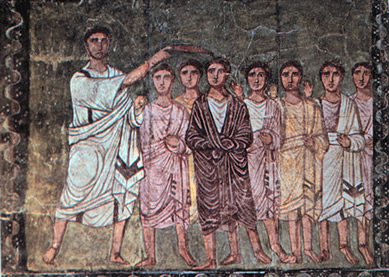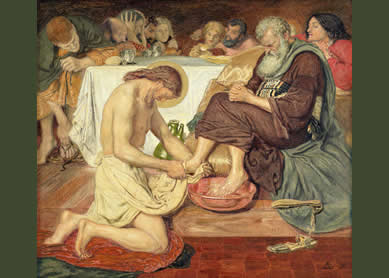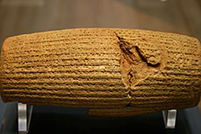If I say “Christ,” I can be certain that most of my audience will think of the name Jesus. That’s because many today treat Christ like a last name, allowing them to refer to Jesus as they do their heads of state: May, Macron, Merkel, Putin, and Trump. But, in fact, the word Christ (Greek Christos) is simply the Greek rendering of the Hebrew word for messiah (meshiakh), an ancient priest or king whom YHWH anointed to rule over Israel. There are many “messiahs” throughout the Hebrew Bible, just as there have been many messianic claimants throughout history. Depending on whom you asked, the messiah could be Zerubbabel ben Shealtiel, Jesus of Nazareth, Simon bar Kokhba, or even Herod the Great. While Christians unite in their confession that Jesus is the messiah, messianic expectations in Judaism are widely diverse.
Who is the messiah, and what should he look like?
Monty Python’s Life of Brian tells the story of a man who has the misfortune of being mistaken for the messiah. At one point, an exacerbated Brian confronts his would-be followers, “I am not the messiah!” to which a member of the crowd responds, “I say that you are! And I should know, lord, I’ve followed a few.” Although he continues to insist that he is not the messiah, the hapless Nazarene doth protest too much; as one woman reminds the crowd, “Only the true messiah denies his divinity!” “Well, what sort of chance does that give me?” asks Brian, “Alright, I am the messiah!” to which the crowd responds, “He is! He is the messiah!”
Comical as it may be, this scene aptly illustrates the paradox of messianism. On the one hand, messianism entails a strong sense of how a messiah should look and behave, features that are mediated through idealized traditions about ancient kings and priests. One of the constant themes in Life of Brian, for example, is that the messiah would be an upstart military leader, like a young David (see 1Sam 16:13). On the other hand, messianism negotiates scriptural traditions in light of current experience. The claim “only the true messiah denies his divinity,” for instance, filters messianic expectations through Christian traditions about one particular messiah, Jesus of Nazareth.
The intersection of scriptural tradition and empirical experience is at the heart of ancient discourse about messiahs. Early Jesus believers read their scriptures in light of their messiah’s resurrection (see Luke 24:25-27, Luke 24:44-49). For some, Jesus is the son of David whom God raised and enthroned as son of God (Rom 1:3-4; cf. 2Sam 7:12-14; Ps 2:7). For others, it was significant that God anointed him as a priest (Heb 5:1-10; Heb 7:1-9:28). Such claims may be compared to the Qumran sectarians’ ideal of a diarchic political structure—the messiahs of Aaron and Israel—or to the royal claimants mentioned by Josephus (J.W. 2.434; Ant. 17.278) or to the short rule of Simon bar Kokhba, who called himself nasi Israel, “ruler of Israel” (cf. Ezek 34:24; Ezek 37:25). Thus, while messianism is hardly an exercise in scribal fantasy, it does seem to be the case that, if one were so inclined, she could find scriptural warrant to conclude, “He is! He is the messiah!”
When does the son-of-man tradition align with messianic expectations?
Writing during the tumultuous reign of Antiochus IV Epiphanies (ca. 167 BCE), the scribe of Dan 7 narrates his vision of the divine throne room: “I saw one like a human being coming with the clouds of heaven. And he came to the Ancient One and was presented before him. To him was given dominion and glory and kingship, so that all peoples, nations, and languages should serve him. His dominion is an everlasting dominion that shall not pass away, and his kingship is one that shall never be destroyed” (Dan 7:13-14). Who is this one like a human being (lit. “like a son of man”)? (Note: In the Hebrew Bible, the Aramaic term bar enash, along with its Hebrew cognate ben adam [see, e.g., Ps 8:5; Ezek 2:1], functions as a generic designation for mortals or descendants of Adam.)
While scholars dispute the identity of the son-of-man figure, the reception history of Dan 7 strongly points in one direction: he is the messiah. Certainly, this was the conclusion of the early Jesus movement. While we find hints of this motif in letters of Paul (see 1Cor 15:24), Jesus is explicitly identified as Daniel’s son of man in all four canonical gospels as well as in Revelation. Most strikingly, the Synoptic Gospels portray Jesus responding to the high priest’s question, “Are you the messiah?” by interpreting “messiah” to mean the figure mentioned in Dan 7 (Mark 14:61-62 parr.).
Of course, Christian messianism did not have a monopoly on the son-of-man figure. The Babylonian Talmud transmits a tradition in the name of R. Aqiva, wherein the second-century tanna exploits the mention of multiple thrones in Dan 7:9: “One was for him [God] and the other one was for David” (b. Sahn. 38b). While this notion is sharply censured by R. Yose, it may preserve a strand of interpretation that dates back to the first century CE. The Parables of Enoch (1En. 37-71), some form of which many specialists date prior to the composition of the Synoptic Gospels, envisages a son-of-man figure seated on the heavenly throne of Israel’s God (see 1En 62:2, 1En 62:5). Moreover, the late-first century CE scribe “Ezra” espies a son-of-man figure who will arise from the sea and rule over the nations from atop Mount Zion (4Ezra 13). As in the tradition attributed to R. Aqiva, both the Parables of Enoch and 4 Ezra identify this son of man as the “messiah” of Ps 2.
So, while we may never be able definitively to answer the question of who Daniel’s “one like a son of man” was originally, we can conclude, with relative confidence, when he became the messiah: by the mid-first century CE, at the latest.
Bibliography
- Novenson, Matthew V. The Grammar of Messianism: An Ancient Jewish Political Idiom and Its Users. New York: Oxford University Press, 2017.
- Charlesworth, James H. The Messiah: Developments in Earliest Judaism and Christianity. Minneapolis: Fortress, 1992.
- Collins, John J. The Scepter and the Star: Messianism in Light of the Dead Sea Scrolls. 2nd edition. Grand Rapids: Eerdmans, 2010.





